List of monarchs of Brazil
| Monarchy of Brazil | |
|---|---|
|
Imperial | |
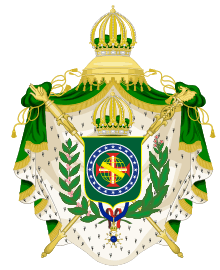 | |
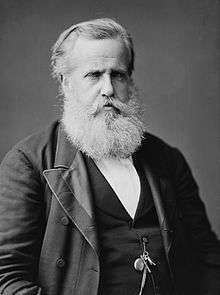 Pedro II | |
| Details | |
| Style | |
| First monarch |
Maria I (as Queen) |
| Last monarch |
Pedro II (as Emperor) |
| Formation | 16 December 1815 |
| Abolition | 15 November 1889 |
| Residence | |
| Appointer | Hereditary |
| Pretender(s) | Prince Luiz of Orléans-Braganza |
Brazil was ruled by a series of monarchs in the period 1815–1889; first as a kingdom united with Portugal in the United Kingdom of Portugal, Brazil and the Algarves (1815–1822), subsequently as a sovereign and independent state, the Empire of Brazil (1822–1889). All four of the country's monarchs were members of the House of Braganza.
Before 1815, Brazil was a colony of the Kingdom of Portugal. Thus, from the formal arrival of the Portuguese in 1500, when the land was claimed by the Portuguese Crown, until 1815 when the Kingdom of Brazil was created and the colonial bond was formally terminated and replaced by a political union with Portugal, the Kings of Portugal were monarchs over Brazil.
During the colonial era, from 1645 onwards, the heir apparent of the Portuguese Crown was styled Prince of Brazil. In 1817, in the wake of the creation of the United Kingdom of Portugal, Brazil and the Algarves, the heir apparent's title was changed to Prince Royal.
Brazil had two monarchs during the United Kingdom epoch: Queen Maria I (1815–1816) and King John VI (1816–1822). By the time of the creation of the United Kingdom of Portugal, Brazil and the Algarves, Queen Maria I was long incapacitated, and the Portuguese Empire was ruled by Prince John, the future King John VI, as Prince Regent.
As an independent nation-state, Brazil had two monarchs: Emperors Pedro I (1822–1831) and Pedro II (1831–1889). In 1889, the monarchy was abolished in a military coup d'état that proclaimed Brazil a republic.
During the imperial era, King John VI of Portugal briefly held the honorific style of Titular Emperor of Brazil under the 1825 Treaty of Rio de Janeiro, by which Portugal recognized the independence of Brazil. The style of Titular Emperor was a life title, and became extinct upon the holder's demise. John VI held the imperial title for a few months only, from the ratification of the Treaty in November 1825 until his death in March 1826. During those months, however, as John's imperial title was purely honorific, Emperor Pedro I remained the sole monarch of the empire.
Predecessors
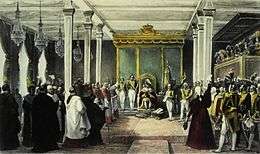
Members of the House of Braganza had already ruled Brazil as part of the Kingdom of Portugal since the restoration of the independence of Portugal in 1640. Previous Portuguese monarchs of other royal houses also ruled the Colony of Brazil from Lisbon since 1500. Thus the monarchical title to Brazil was created only in 1815 when the colony was elevated to the status of Kingdom equal and united with Portugal, after seven years of the Portuguese court's stay in Rio de Janeiro. The Kingdom of Brazil was a country inside the United Kingdom of Portugal, Brazil and Algarves in dynastic union under the Portuguese crown. However, there was never exactly a title of King of Brazil, but King of the United Kingdom of Portugal, Brazil and Algarves. The main difference is that the previous Portuguese Kings and the Kings of Brazil ruled the country as an absolute monarchy until 1822 in personal union with the Kingdom of Portugal until the independence and subsequent creation of the Empire of Brazil, which was ruled by the Emperors as a constitutional monarchy until its deposition in 1889 in a military coup d'état.
Imperial title
The title of Emperor was created after independence to designate the monarch of Brazil. The choice of Emperor, instead of King, was a suggestion of José Bonifácio de Andrada to discredit the royal title of the Portuguese monarchy of the Kings of Brazil, but also to live up to the continental size of the national territory. Pedro was acclaimed as Constitutional Emperor on 12 October 1822 and crowned on 1 December. His title "Perpetual Defender of Brazil" was given to him by acclamation when he was Prince Royal of the United Kingdom of Portugal, Brazil and the Algarves and Regent of the Kingdom of Brazil and was later made part of the official regnal title of the Emperors of Brazil.
Full titles

The Brazilian monarchs had an extensive list of titles and claims that reflected the geographic expanse and diversity of the lands ruled by the House of Braganza.
Maria I: Her Most Faithful Majesty Maria I, By the Grace of God, Queen of the United Kingdom of Portugal, Brazil, and the Algarves, of either side of the sea in Africa, Lady of Guinea and of Conquest, Navigation and Commerce of Ethiopia, Arabia, Persia and India, etc.
João VI: His Most Faithful Majesty João VI, By the Grace of God, King of the United Kingdom of Portugal, Brazil, and the Algarves, of either side of the sea in Africa, Lord of Guinea and of Conquest, Navigation and Commerce of Ethiopia, Arabia, Persia and India, etc.
Pedro I: His Imperial Majesty Pedro I, By the Grace of God and Unanimous Acclamation of the Peoples, Constitutional Emperor and Perpetual Defender of Brazil.
His Imperial and Most Faithful Majesty Pedro I & IV, By the Grace of God and Unanimous Acclamation of the Peoples, Constitutional Emperor and Perpetual Defender of Brazil, King of Portugal and the Algarves, of either side of the sea in Africa, Lord of Guinea and of Conquest, Navigation and Commerce of Ethiopia, Arabia, Persia and India, etc. (in 1826)
Pedro II: His Imperial Majesty Pedro II, By the Grace of God and Unanimous Acclamation of the Peoples, Constitutional Emperor and Perpetual Defender of Brazil.
Kings of Brazil (1815-1822)
| Name | Lifespan | Reign start | Reign end | Notes | Family | Image |
|---|---|---|---|---|---|---|
Mary I
| 17 December 1734 – 20 March 1816 (aged 81) | 16 December 1815 | 20 March 1816 | Braganza |  | |
John VI
| 13 May 1767 – 10 March 1826 (aged 58) | 20 March 1816 | 7 September 1822 | Son of Mary I | Braganza |  |
Emperors of Brazil (1822-1889)
| Name | Lifespan | Reign start | Reign end | Notes | Family | Image |
|---|---|---|---|---|---|---|
Peter I
| 12 October 1798 – 24 September 1834 (aged 35) | 12 October 1822 | 7 April 1831 | Son of John VI | Braganza | 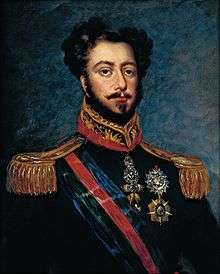 |
Peter II
| 2 December 1825 – 5 December 1891 (aged 66) | 7 April 1831 | 15 November 1889 | Son of Peter I | Braganza | 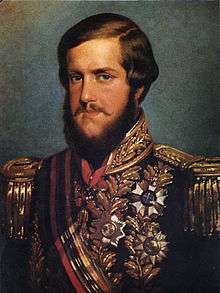 |
Claimants to the throne of Brazil (1889–present)
Since the Proclamation of the Republic, the exiled monarch Pedro II did not consider himself either as pretender or monarch, although Pedro II never formally abdicated. He continued to be treated as "His Imperial Majesty the Emperor". After his death in 1891, his daughter and heiress, Isabel, Princess Imperial of Brazil, was recognized by the Brazilian monarchists as Empress de jure, while formally titled Head of the Imperial Family of Brazil. Since then, the pretender to the title of Emperor is called Head of the Imperial House of Brazil; The heir apparent to the throne bore the title of Prince Imperial of Brazil; the heir presumptive, oldest children of the Prince Imperial, is titled Prince of Grão-Pará; The other Princes are simply Princes of Brazil.
Isabel's successor was her grandson, Prince Pedro Henrique of Orléans-Braganza, since her eldest son resigned his rights in 1908 and her second son died earlier than she. Pedro Henrique actively claimed the imperial throne of Brazil until his death in 1981. He was succeeded by his eldest son, Prince Luiz of Orléans-Braganza, who is currently the claimant and active. Without children, his heir apparent is Bertrand, Prince Imperial of Brazil, his brother.
The Heads of the Imperial House of Brazil:
- Emperor Pedro II (15 November 1889 – 5 December 1891)
- Isabel, Princess Imperial of Brazil (5 December 1891 – 14 November 1921)
- Prince Pedro Henrique of Orléans-Braganza (14 November 1921 – 5 July 1981)
- Prince Luiz of Orléans-Braganza (5 July 1981 – present)
- Heir apparent: Bertrand, Prince Imperial of Brazil
Timeline

.svg.png)

.svg.png)
.png)